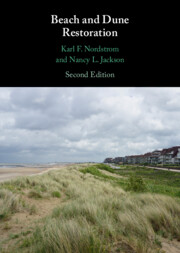Book contents
- Beach and Dune Restoration
- Reviews
- Beach and Dune Restoration
- Copyright page
- Contents
- Contributors
- Preface
- Acknowledgments
- 1 The Need for Restoration
- 2 Beach Nourishment and Impacts
- 3 Dune Building Practices and Impacts
- 4 Restoring Processes, Structure, and Functions
- 5 Altering or Removing Shore Protection Structures
- 6 Options in Spatially Restricted Environments
- 7 Stakeholder Interests, Conflicts, and Cooperation
- 8 A Locally Based Program for Beach and Dune Restoration
- 9 Research Needs
- References
- Index
5 - Altering or Removing Shore Protection Structures
Published online by Cambridge University Press: 09 December 2021
- Beach and Dune Restoration
- Reviews
- Beach and Dune Restoration
- Copyright page
- Contents
- Contributors
- Preface
- Acknowledgments
- 1 The Need for Restoration
- 2 Beach Nourishment and Impacts
- 3 Dune Building Practices and Impacts
- 4 Restoring Processes, Structure, and Functions
- 5 Altering or Removing Shore Protection Structures
- 6 Options in Spatially Restricted Environments
- 7 Stakeholder Interests, Conflicts, and Cooperation
- 8 A Locally Based Program for Beach and Dune Restoration
- 9 Research Needs
- References
- Index
Summary
Chapter 5 discusses actions to alter or remove shore protection structures to help restore landforms and habitats. The case is made for the need for sediment and space to sustain natural features, the need to connect landforms and habitats by sediment transfers, and the need to allow for migration of topographic features offshore, onshore, and alongshore. The importance of coastal erosion in providing sediment and space is highlighted as is the importance of erosional landforms (e.g., bluff faces) as threatened habitat. Managed retreat by removing shore protection structures is evaluated in terms of technical feasibility and stakeholder concerns. Decision support criteria and case studies are provided to assess feasibility of managed retreat. Suggestions are made for altering the dimensions or surface characteristics of protection structures to increase sediment transfers or favor habitat. Burial of hard shore protection structures and other nature-based solutions are evaluated as ways to reestablish some of the natural process-response relationships between waves and currents and faunal interactions and increase the aesthetic and recreational value of the shore.
Keywords
- Type
- Chapter
- Information
- Beach and Dune Restoration , pp. 123 - 145Publisher: Cambridge University PressPrint publication year: 2021



